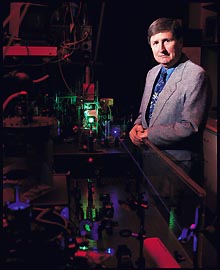|
This is an archived article.
For the latest news, go to the
Advance Homepage
For more archives, go to the Advance Archive/Search Page. | ||
|
Ultracold Research a Hot
Topic in Physics Department
Ultracold physics, the field which describes atoms and molecules as cold as one millionth of room temperature, has become a specialty of UConn's physics department. The field opened up to exploration in the early 1980s owing to new techniques such as laser cooling and trapping of atoms, and it promises widespread applications. Since space is cold, ultracold physics may help explain the chemistry of comets, planets, and clouds of gas in space, for example.
During the past few years, UConn has extended its expertise into this area, a subfield of atomic, molecular, and optical physics, which is a longstanding strength of the physics faculty. Department head Bill Stwalley, himself an ultracold researcher, views ultracold physics as a promising frontier. He has helped build an ultracold physics group that now includes six faculty, five postdocs, and 16 graduate students. They form one of the largest ultracold research groups in the country and have established a national reputation as leaders in the field, with support totaling approximately $1 million in major grants each year from the National Science Foundation, NASA, and the Department of Energy. "They're very very important," says Michael Chapman, a professor of physics at the Georgia Institute of Technology and an ultracold researcher. "They have unique strengths." One of the group's special contributions is the study of collisions between ultracold atoms. Understanding these collisions sheds light on Bose-Einstein condensation, one of the key findings of ultracold physics. A Bose-Einstein condensate is a form of matter into which atoms can coalesce at ultracold temperatures. In a Bose-Einstein condensate, all the atoms move as one body. "It's a new form of matter in which all atoms behave like one," says Juha Javanainen, a professor of physics. Bose-Einstein condensates were postulated 70 years ago by Indian physicist Satyendra Nath Bose, and German physicist Albert Einstein, Javanainen says. Yet it was just six years ago that a team at the University of Colorado first produced and observed a pure Bose-Einstein condensate. Since that time, says Javanainen, "the theory has exploded, for the reason that you can now make comparisons with the observations, and they work." A colleague of Javanainen, Robin Cote, an assistant professor of physics, is advancing the theory of ultracold collisions by studying scattering lengths. The scattering length measures how close two atoms can get before they collide. Cote says scattering lengths are the key to understanding collisions between ultracold atoms: "In the atom-atom collision, you want to know the scattering length, the radius of the interaction zone." The scattering length, though difficult to predict, determines whether or not a material will form a stable Bose-Einstein condensate, he says. Stable Bose-Einstein condensates are easier to produce in the lab. Cote is studying different materials to see which ones might be interesting in low temperature experiments. While Javanainen and Cote study the theoretical aspects of collisions and of Bose-Einstein condensates, the four other faculty in the ultracold group conduct experiments. Professors Stwalley, Philip Gould, and Edward Eyler are studying various ultracold atoms and molecules by producing Bose-Einstein condensates. Gould and Eyler are also collaborating on a project that may be a step toward producing a quantum computer, a type of technology that could perform some tasks many times faster than today's computers. A quantum computer could, for example, break many of today's computer codes in a second or less, according to Eyler. Winthrop Smith, a professor of physics, is studying ultracold ions, atoms and molecules that have an electrical charge. For research that has potentially huge implications, the apparatus Smith uses is deceptively compact. "We can do the experiments basically on a tabletop," he says. Gould uses lasers to produce and study ultracold atoms in his lab. Laser light can be used to cool atoms because it exerts a force, explains Gould. Even ordinary lights exert a force, he says, although it can't be felt: "If you hold your hand out under a light, that light is exerting a force on your hand. You can't feel it because it's not very big." Gould uses the force exerted by laser light to slow atoms down, which is what is needed to cool them. Moving atoms, he says, absorb different wavelengths of light than do stationary atoms. This causes the lasers to act mainly on the moving atoms and eventually bring the atom sample nearly to a halt. The technique establishes a set of conditions known as "optical molasses." With a forest of mirrors used to direct several lasers, Gould can produce and make measurements on Bose-Einstein condensates. Although his research is on the cutting edge of his field, not all the apparatus in Gould's lab is unfamiliar to the layman. "We tend to use diode lasers for everything," he says. "These are the same type of diode lasers that are used in CD players." The field of lasers and slow molecules may lead to technologies as yet unenvisaged. "When you have major new discoveries," says Javanainen, "there will be strange new technologies. When they were inventing lasers 40 years ago, no one had a clue what to do with them. When you have a fundamental enough discovery, no matter how obscure and remote, it will change the world around us." Brent C. Evans |
 he physics department is hot on the trail of a cold
subject. Ultracold, in fact.
he physics department is hot on the trail of a cold
subject. Ultracold, in fact.
